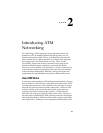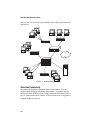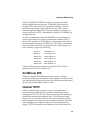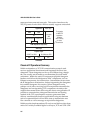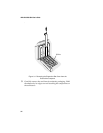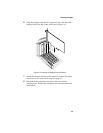
2-6
ANA-5910/5930/5940 User’s Guide
numerous interconnected networks. This section introduces the
TCP/IP protocol suite which ATM necessarily supports untouched.
Classical IP Operational Summary
Within workstations, a TCP/IP communication protocol stack
receives application data streams and fragments the flows into
datagrams. These datagrams can be up to 64 Kbytes long, though
they are usually much smaller to accommodate physical media
constraints. Within the stack, IP components prepend datagram
headers and deliver the datagram to MAC components, such as
Ethernet components, for transmission. Intermediate routers route
the IP datagrams to destinations, further fragmenting the datagrams
into smaller datagrams if necessary. When datagrams arrive,
perhaps out of order, receiving host IP components reassemble the
datagrams and corresponding TCP components reconstruct the
original data stream before delivering the data to an application. IP
provides a connectionless, datagram transmission and routing
conduit while TCP superimposes necessary guaranteed data
delivery considerations between applications using mechanisms
such as exponential back off and slow start up transmission rate
flow controls as well as message receipt acknowledgments.
Within popular implementations, IP receives and delivers data from
and to two widely available higher level layers, TCP and UDP. UDP
Application Native App.
UDP TCP
IP
LAN Emulation Classical IP
accesses
AAL
directly
For example,
an MPEG-II
application
accesses
AAL 5 directly
for video
transmission
ATM Adaptation Layer (AAL)
Signalling
ATM Layer
Physical Layer
ATM Model
SONET and SDH
MMF STPUTP
25.6-Mbit/sec ATM






